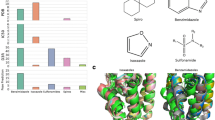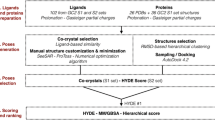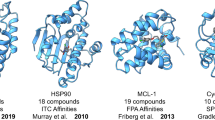Abstract
Drug design is a multi-parameter task present in the analysis of experimental data for synthesized compounds and in the prediction of new compounds with desired properties. This article describes the implementation of a binned scoring and composite ranking scheme for 11 experimental parameters that were identified as key drivers in the MC4R project. The composite ranking scheme was implemented in an AstraZeneca tool for analysis of project data, thereby providing an immediate re-ranking as new experimental data was added. The automated ranking also highlighted compounds overlooked by the project team. The successful implementation of a composite ranking on experimental data led to the development of an equivalent virtual score, which was based on Free-Wilson models of the parameters from the experimental ranking. The individual Free-Wilson models showed good to high predictive power with a correlation coefficient between 0.45 and 0.97 based on the external test set. The virtual ranking adds value to the selection of compounds for synthesis but error propagation must be controlled. The experimental ranking approach adds significant value, is parameter independent and can be tuned and applied to any drug discovery project.












Similar content being viewed by others
References
Nozawa D, Chaki S, Nakazato A (2008) Recent advances in the development of melanocortin-4 receptor ligands. Exp Opin Ther Pat 18:403–427
AstraZeneca International Bioscience Information System (IBIS) (www.bio-itworld.com/BioIT_Article.aspx?id=78250)
Hutter MC (2009) In silico prediction of drug properties. Curr Med Chem 16:189–202
Cramer RD III, Patterson DE, Bunce JD (1988) Comparative molecular field analysis (CoMFA). 1. Effect of shape on binding of steroids to carrier proteins. J Am Chem Soc 110:5959–5967
Chadwick A, Hajek M (2004) Learning to improve the decision-making process in research. Drug Discov Today 9:251–257
Li H, Yap CW, Xue Y, Li ZR, Ung CY, Han LY, Chen YZ (2005) Statistical learning approach for predicting specific pharmacodynamic, pharmacokinetic, or toxicological properties of pharmaceutical agents. Drug Dev Res 66:245–259
Duch W, Swaminathan K, Meller J (2007) Artificial intelligence approaches for rational drug design and discovery. Curr Pharm Des 13:1497–1508
Yap CW, Xue Y, Li H, Li ZR, Ung CY, Han LY, Zheng CJ, Cao ZW, Chen YZ (2006) Prediction of compounds with specific pharmacodynamic, pharmacokinetic or toxicological property by statistical learning methods. Mini-Rev Med Chem 6:449–459
Yap CW, Li H, Ji ZL, Chen YZ (2007) Regression methods for developing QSAR and QSPR models to predict compounds of specific pharmacodynamic, pharmacokinetic and toxicological properties. Mini-Rev Med Chem 7:1097–1107
Mager DE (2006) Quantitative structure-pharmacokinetic/pharmacodynamic relationships. Adv Drug Deliv Rev 58:1326–1356
Free SMJ, Wilson JW (1964) A mathematical contribution to structure-activity studies. J Med Chem 7:395–399
Craig PN (1972) Comparison of the Hansch and Free-Wilson approaches to structure-activity correlation. Adv Chem Ser 114:115–129
Kubinyi H, Kehrhahn OH (1976) Quantitative structure-activity relationships. 3.1 A comparison of different Free-Wilson models. J Med Chem 19:1040–1049
Hansch C, Maloney PP, Fujita T, Muir RM (1962) Correlation of biological activity of phenoxyacetic acids with Hammett substituent constants and partition coefficients. Nature (London, UK) 194:178–180
Hansch C, Muir RM, Fujita T, Maloney PP, Geiger F, Streich M (1963) The correlation of biological activity of plant growth regulators and chloromycetin derivatives with Hammett constants and partition coefficients. J Am Chem Soc 85:2817–2824
Jorissen RN, Reddy G, Kiran Kumar S, Ali A, Altman MD, Chellappan S, Anjum SG, Tidor B, Schiffer CA, Rana TM, Gilson MK (2009) Additivity in the analysis and design of HIV protease inhibitors. J Med Chem 52:737–754
Sciabola S, Stanton RV, Johnson TL, Xi H (2011) Application of Free-Wilson selectivity analysis for combinatorial library design. Methods Mol Biol 685:91–109
Hoefgen N, Stange H, Schindler R, Lankau H, Grunwald C, Langen B, Egerland U, Tremmel P, Pangalos MN, Marquis KL, Hage T, Harrison BL, Malamas MS, Brandon NJ, Kronbach T (2010) Discovery of Imidazo[1,5-a]pyrido[3,2-e]pyrazines as a new class of phosphodiesterase 10A inhibitors. J Med Chem 53:4399–4411
Patel Y, Gillet VJ, Howe T, Pastor J, Oyarzabal J, Willett P (2008) Assessment of additive/nonadditive effects in structure-activity relationships: implications for iterative drug design. J Med Chem 51:7552–7562
Tomic S, Nilsson L, Wade RC (2000) Nuclear receptor-DNA binding specificity: a COMBINE and Free-Wilson QSAR analysis. J Med Chem 43:1780–1792
Freeman-Cook KD, Amor P, Bader S, Buzon LM, Coffey SB, Corbett JW, Dirico KJ, Doran SD, Elliott RL, Esler W, Guzman-Perez A, Henegar KE, Houser JA, Jones CS, Limberakis C, Loomis K, McPherson K, Murdande S, Nelson KL, Phillion D, Pierce BS, Song W, Sugarman E, Tapley S, Tu M, Zhao Z (2012) Maximizing lipophilic efficiency: the use of Free-Wilson analysis in the design of inhibitors of acetyl-CoA carboxylase. J Med Chem 55:935–942
Kubinyi H (1988) Free-Wilson analysis. Theory, applications and its relationship to Hansch analysis. Quant Struct Act Relat 7:121–133
Kubinyi H (2004) 2D QSAR models: Hansch and Free-Wilson analyses. Comput Med Chem Drug Discov, 539–570
Valko K, Bevan C, Reynolds D (1997) Chromatographic hydrophobicity index by fast-gradient RP-HPLC: a high-throughput alternative to log P/log D. Anal Chem 69:2022–2029
(2009) Phase version 3.1, Schrodinger, LLC New York, NY
(2011) MacroModel version 9.9, Schrodinger, LLC New York, NY
JMP Statistical Software (www.jmp.com/software)
TIBCO Spotfire (spotfire.tibco.com)
Compumine, Rule Discovery System (www.compumine.com)
Wold H (1966) Nonlinear estimation by iterative least squares procedures. In: David FN (ed) Research papers in statistics. Wiley, New York, pp 411–444
Wold H (1982) Soft modeling: the basic design and some extensions. In: Joreskog KG, Wold H (eds) Systems under indirect observation: causality-structure-prediction. North-Holland, Amsterdam, vol II, Chap. 1, pp 1–54
Wold H (1985) Partial least squares. In: Kotz S, Johnson NL (eds) Encyclopedia of statistical sciences. Wiley, New York, vol 6, pp 581–591
SIMCA P + (www.umetrics.com)
Cosgrove D. AstraZeneca internal development
Harrison M. AstraZeneca internal development
Rogers D, Brown RD, Hahn M (2005) Using extended-connectivity fingerprints with Laplacian-modified Bayesian analysis in high-throughput screening follow-up. J Biomol Screen 10:682–686
Rogers D, Hahn M (2010) Extended-connectivity fingerprints. J Chem Inf Model 50:742–754
Topliss JG, Edwards RP (1979) Chance factors in studies of quantitative structure-activity relationships. J Med Chem 22:1238–1244
Leach AG, Jones HD, Cosgrove DA, Kenny PW, Ruston L, MacFaul P, Wood JM, Colclough N, Law B (2006) Matched molecular pairs as a guide in the optimization of pharmaceutical properties; a study of aqueous solubility, plasma protein binding and oral exposure. J Med Chem 49:6672–6682
Acknowledgments
Thanks to Thomas Leek for providing statistics for the chromatographic LogD74 model. Stephan Hjorth is acknowledged for strong support during the development of the models. Alleyn Plowright, Christian Tyrchan, Anders Hogner and Niklas Blomberg are acknowledged for constructive criticism of the manuscript.
Author information
Authors and Affiliations
Corresponding author
Electronic supplementary material
Below is the link to the electronic supplementary material.
Rights and permissions
About this article
Cite this article
Nilsson, I., Polla, M.O. Composite multi-parameter ranking of real and virtual compounds for design of MC4R agonists: Renaissance of the Free-Wilson methodology. J Comput Aided Mol Des 26, 1143–1157 (2012). https://doi.org/10.1007/s10822-012-9605-7
Received:
Accepted:
Published:
Issue Date:
DOI: https://doi.org/10.1007/s10822-012-9605-7




